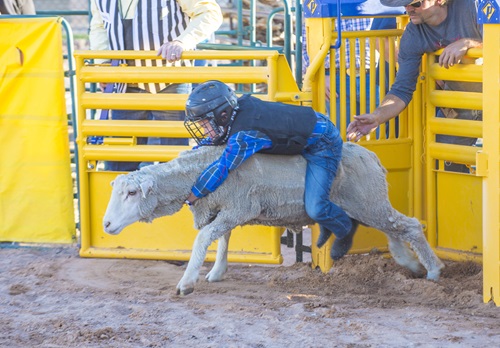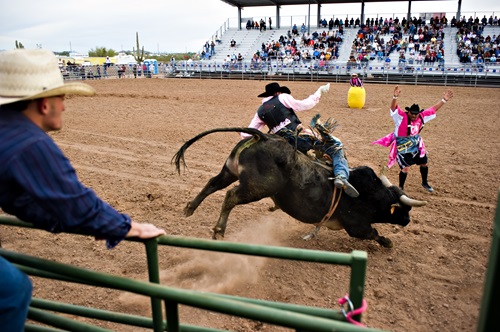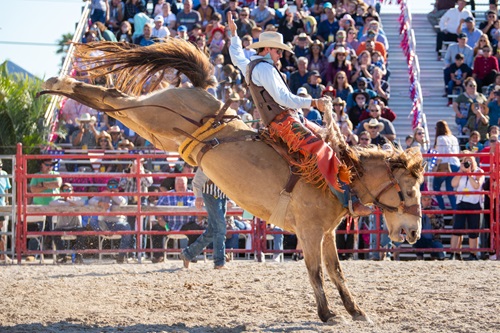
Ah, summertime. Kids are out of school, the sun is shining, and in every state (and in most counties), it’s fair season. Fairs provide live music, cookoffs for chili, barbecue and more, an education in agriculture, a chance to compete for ribbons in produce, crafts and art – and for many, a chance to see, live and up close, the sport of rodeo.
And that, according to proponents, is one of the best things that will happen this summer. After all, fairs have a long history of enlightening people about the sport.
“The history of rodeos originally began from the tradition of Wild West shows,” notes the WilCo Fair and Rodeo of Williamson County, Texas. “These shows, which first began in the 1870's, featured life on the American frontier as demonstrated by cowboy performers. For over 40 years, these acting troupes would travel all across the country (and internationally) to entertain folks with incredible rodeo stunts and tricks. Some of the most famous figures include "Buffalo Bill", who founded Buffalo Bill's Wild West in 1883, and Bill Pickett, who was born in what is now Georgetown, Texas.”
 And with attendance at fairs increasing nationwide, there’s a strong chance that audience for American history is growing. Many spectators will go on to watch rodeo online and on television (and to follow social channels for athletes and events), while others may take on some of the activities themselves.
And with attendance at fairs increasing nationwide, there’s a strong chance that audience for American history is growing. Many spectators will go on to watch rodeo online and on television (and to follow social channels for athletes and events), while others may take on some of the activities themselves.
Rodeo is a uniquely American sport and its profile has never been higher. Organizations like the Youth Rodeo Association, the National High School Rodeo Association and the National Intercollegiate Rodeo Association (by the way, there are rodeo scholarships to some colleges) all provide a feeder system into the sport.
But it all starts with awareness. And while some areas, like the Southwest, have an ingrained history of rodeo, bringing the sport to other areas means building the excitement.
In 2022, Jerome Davis, the coach of professional bull riding team, Carolina Cowboys, told reporters at Wrangler Network that showcasing the skill it takes to ride a bull, for example, is a big goal. Creating a following in the Southeast was the next step.
“I hope that’s what happens,” Davis said with a sly grin. “We’ve got the fan base already. That’s one thing about over in the Carolinas – they love bull riding, and it’s been a hotbed over there for rodeos and bull ridings for years. Now that we’ve got a team, I feel like they’re going to back it.”
Fairs are the perfect way to do that. Paying a nominal admission fee to get in the gates allows families (who otherwise might only be headed for rides and games) to watch rodeo events free of charge.
Making rodeo family-friendly (and encouraging kids to take part in low-risk activities) is another win.
The Edmonson Voice noted that the County Lions Club Fair hosted the Tennessee-based Bullwhip Rodeo, for example. Dale Burton, Arena Director for the Bullwhip Rodeo said the goal for their program is to provide a good family show.
"We like to include a little bit of everything in our rodeo," he said. "Everything from the little kids, all the way up to the cowboys riding the big bulls. We want to try to include something for everyone. And I believe we have a good, fair rodeo for our competitors."
The article noted, “The event included mutton riding for the little kids, which is always a fan-favorite at the rodeo. Small ones clung to sheep as they were released from the pen, some lasting longer than the 8-second requirement for the bull riders. Also for the kids was cattle wrangling, where kids had the opportunity to chase down calves with a pink ribbon tied to their tails. Prizes were offered to the kids that could grab the ribbons.”
The rodeo was aspiration, as well, with a stunt rider who rode laps upside down as well as standing up, barrel racing for both rodeo and local riders, a steer wrangling event for any team of three that could wrestle a steer and ride it for a required amount. There were also two different calf roping events, one for solos and teams, with bull riding as the final event of the evening.
 The Tri-City Herald had a timeline of its local rodeo. Highlights included this entry:
The Tri-City Herald had a timeline of its local rodeo. Highlights included this entry:
“1976: A 1,400-pound steer broke free from its 18-year-old owner, creating pandemonium for 90 minutes and injuring a woman. When a 9-year-old West Richland girl's horse refused to be loaded in a trailer, she rode it to the fairgrounds, got lost and created a bit of panic before finally arriving at 2 a.m. Fair Queen was Kelley La Hue.
Oh, and:
1990: Near-record crowds braved rainy weather to see country singers Roy Clark and Jerry Reed, the latter of Smokey and the Bandit fame. Fairgoers told an official they'd "face the prospect of drowning" to see Clark. Queen was K.C. Ross.”
And in those moments, said enthusiasts, rodeo fans (and future athletes) have been born. Because, at the end of the day, kids realized it was more than a show, more than entertainment.
They understood, said public radio station KCUR in Kansas City, “the hard work it takes to care for an animal 10 times their size. The hours of practice required to master skills that most adults can’t pull off. The grit they need to ride into the arena, where every kid but one ends up leaving a loser.”
And thanks to fairs, rodeo is opening up to participants from all walks of life. The nationwide youth rodeo organization, National Little Britches Rodeo Association, fielded more than 1,400 competitors in 2022 and paid out nearly $275,000 in prizes. There are now adult rodeo associations that cater specifically to women, Black Americans, Native Americans and LGBTQ individuals as well.
Who knew rodeo was inclusive? Maybe rodeo people but fairs are helping to spread the word far and wide.
AnimalAgAlliance, in a blog entry entitled, More Than a State Fair, notes, “the agricultural industry needs livestock shows. Hear me out: these shows help expose the next generation of agriculturalists to the world we all know and love. Granted, some of them would have found it anyway thanks to their families. However, there is an entire percentage of agriculturalists who were not raised on or around a farm. I personally know people who only pursued agriculture as a career due to their exposure to the livestock showing industry. It is a gateway to creating new “agvocates” and supporters. Moreover, the livestock events held at state fairs give us a platform to promote agriculture to the public. It gives us the opportunity to explain our lifestyle and engage with the public on our industry.”
In the face of pushback from groups like PETA, rodeo enthusiasts say the sport teaches participants to respect and care for their animals and in many cases, to form long-lasting bonds with them.
 Already, agritourism is a growing movement, making the science of farming into a not only educational but fun experience.
Already, agritourism is a growing movement, making the science of farming into a not only educational but fun experience.
You don’t need an expert to tell you that agriculture is a field that has been hit hard by the times. Much ag land has been sold to developers who want to put in subdivisions (oddly, with street names like Bridle Path). School districts have consolidated and independent grocery stores are outgunned by chains.
And if there aren’t many other young families around, it might be hard for children there to spend much time with other kids.
So, can youth rodeos help?
“It can’t hurt, right?” Donna Ginther, who leads the Institute for Policy and Social Research at the University of Kansas, told KCUR. “If you have a rodeo, if you have 4-H, if you have FFA (Future Farmers of America), then the kids can get together and do things that they're interested in.”
Today’s fairs offer charging stations for cell phones, booths for everything from garden clubs to gubernatorial candidates – and the chance to meet rodeo athletes and their animals.
And it teaches those who participate about being part of a community.
“After traveling over 45,000 miles, spending 12 years investing in myself and chasing my idols, my last high school rodeo run ended with my rope in the dirt,” noted a blogger in FarmProgress. “But the lessons rodeo taught me about being confident, working hard and being my own role model easily outlasted the sting of a bad last run. From serving as a three-time national officer for the National High School Rodeo Association to giving a princess speech as a second grader, rodeo taught me to be confident. This confidence was inspired by the supportive rodeo community. Standing on a stage to present during a rodeo meeting warranted the same enthusiasm from my peers as competing in the arena. Whether they were there to laugh at my jokes or offer a friendly smile after a bad run, rodeo folks gave me confidence in my purpose and continue to inspire me to be my best self.”
Saddle up, everyone. The next generation of rodeo is coming to counties and fairs all over the USA this summer.

